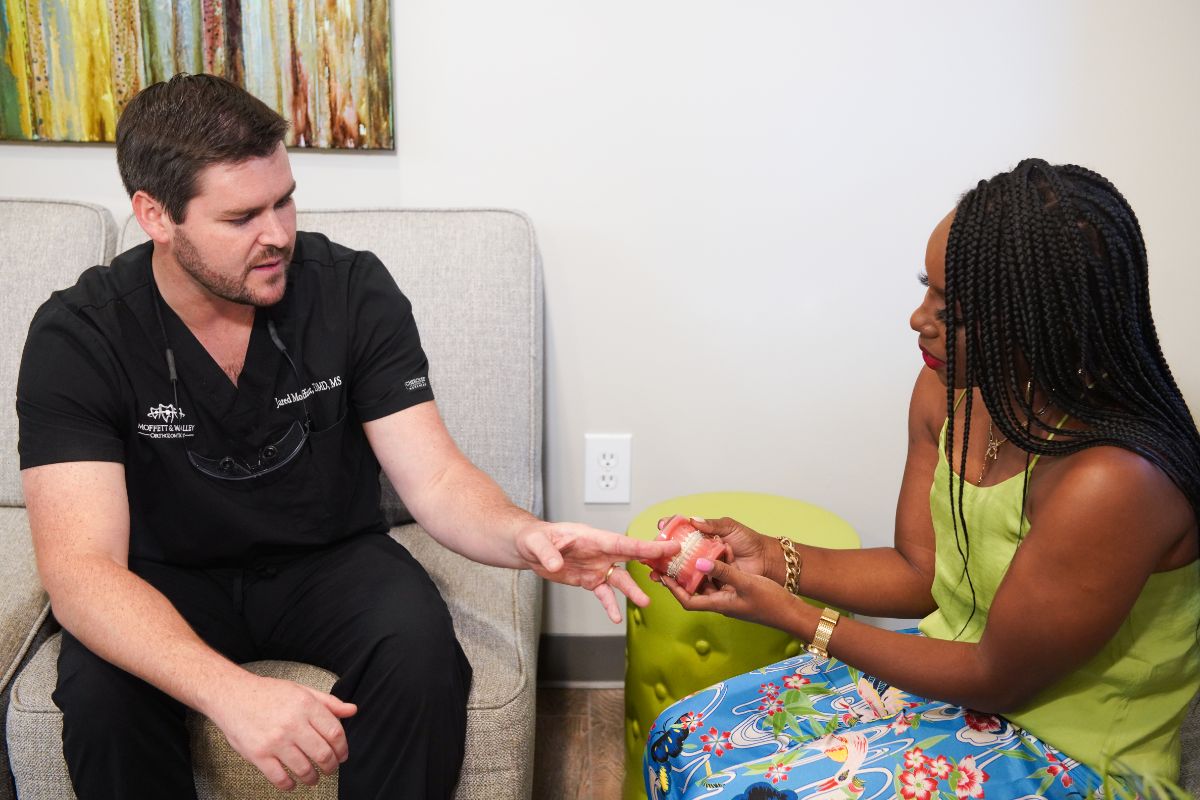There’s a lot that goes into achieving a straighter smile. It takes hard work, dedication, and a willingness to follow your orthodontist’s guidelines. If you wear braces, you already know that oral hygiene plays a key role in the treatment process! The brackets and wires can trap food debris and hide bacteria in the nooks and crannies they create. These can be difficult to clean effectively, but plaque can build up quickly if you don’t brush and floss properly. Over time, this can lead to tooth decay, damaged tooth enamel, and even gum disease.
Here at Moffett & Walley Orthodontics, we’ve seen the effects of poor oral hygiene up close and personal. When cavities and tooth decay are left to spread, it can interrupt a patient’s treatment plan, causing delays and potentially affecting the final results. In the most severe cases, braces may need to be removed temporarily to resolve the problem before resuming treatment. Keeping your mouth healthy is the easiest way to help us achieve the best results in the shortest amount of time possible. Let’s explore our top tips for taking care of your teeth while you’re in braces!
Brush every single day, at least twice a day
Did you know plaque can form and start causing problems within 48 hours? Don’t give it a chance to get comfortable! In an ideal world, you would brush once in the morning, again after every meal, and once more before bed. At a minimum, you should be brushing every morning and night for at least two minutes each time. If you can’t brush right away after eating, rinse your mouth thoroughly with water instead. This will help flush out any lingering food debris.
Use the right kind of toothbrush
There’s no particular toothbrush you need to use with braces, but it should be one with soft bristles. The brackets can put stress on your teeth, and a soft-bristled brush will help reduce additional wear and tear on them. Manual toothbrushes can sometimes leave food particles and plaque behind, no matter how thorough your brushing is. We like electric toothbrushes for the extra power they provide!
Choose a toothpaste with fluoride
As with toothbrushes, there’s no specific toothpaste needed for brushing with braces but we do recommend fluoride toothpaste. Fluoride strengthens your tooth enamel, reduces your risk of tooth decay, and helps minimize the acid erosion that’s caused by certain foods and drinks. Even if you have fluoridated water where you live, you should still use fluoride toothpaste. This will make a big difference to the health of your smile.
Brush your teeth carefully and thoroughly
Once your braces have been placed, you may need to adjust how you brush your teeth. Your usual technique will probably need some adjusting to navigate around the brackets and wires. These recommendations can help you make the most of your brushing!
- Hold the toothbrush against the front sides of the teeth, and move the toothbrush in small circular motions. Try to follow the regular curve of the gums and teeth as you go from tooth to tooth.
- Brush each tooth for several seconds, carefully and slowly, Make sure all food particles are reached and removed along the gum line, between the braces, and on the surface of each tooth.
- Take care to brush the biting surfaces of the teeth, the back sides of the teeth, and behind the molars.
- Don’t forget to brush the roof of your mouth and tongue before rinsing!
- To properly clean the brackets, angle the brush head against them, and remember to brush thoroughly under the wires as well.
Floss every day, even when you don’t feel like it
We get it. Nobody really enjoys flossing, but it’s a critical component of any oral hygiene routine. Aside from flossing between your teeth, you’ll need to get under the archwire of your braces. Floss threaders are a great way to make this a much simpler process! This reusable tool has a stiff end that allows you to floss between the brackets and under the archwire more easily. To ensure you’re flossing your teeth correctly, try following these simple steps.
- Slide a piece of floss about 18 inches long under the wire, above the space between the two teeth. Insert the floss halfway through, then hold both ends of the floss. Carefully slide the floss up and down a few times between the teeth. When the tooth is clean, you’ll be able to hear a slight squeaking sound.
- Floss the gum line with the floss in the shape of a “C” and below the gum line with a soft up and down motion. Be careful not to apply too much pressure when flossing around the archwire.
- Gently remove the floss, thread it under the next wire, and repeat the steps above.
It may take you a while to get through this process in the beginning, but keep at it! A little effort will go a long way, and your smile will thank you for it, during and after treatment.
Add mouthwash to your dental hygiene routine
Mouthwash isn’t meant to replace brushing or flossing, but it can be an excellent tool to boost your oral health! It covers areas of the mouth that a toothbrush and floss may not be able to reach, like the gums and other soft tissues. And if you’ve been struggling with gingivitis, periodontal disease, or even a chronically dry mouth, rinses can be particularly helpful.
Cosmetic rinses will temporarily improve your breath and create a pleasant taste in your mouth but won’t kill the bacteria that cause bad breath. Therapeutic mouthwashes do impact oral bacteria and introduce healthy nutrients into the mouth. Some of the benefits you can expect from adding mouthwash into your daily dental hygiene routine are better breath, greater plaque prevention, more effective brushing and flossing, and a reduced risk of cavities. Ask about mouthwashes designed for use with braces at your next appointment!
Don’t overbrush your teeth
Not brushing enough is bad, but overbrushing your teeth can also be detrimental to your oral health. Brushing too often or too vigorously can cause you to develop sensitive teeth and may contribute to a receding gum line. It can also wear the tooth enamel down. This is another reason we recommend a toothbrush with soft bristles—using a medium- or hard-bristled brush can be too harsh on your teeth. This effect is only amplified by going overboard with your brushing routine. Remember: your technique is much more important than the amount of force you use when brushing!
Give your smile the attention it deserves with Moffett & Walley Orthodontics
There’s an important link between your oral health and achieving the straighter smile you desire. Following the guidelines we’ve listed above will keep your mouth healthy while we work on giving you a better bite!
If you have any questions or concerns about dental hygiene during treatment, we’re always here to help. Are you interested in learning more about how to be proactive with your oral health? Get in touch with us today to schedule a FREE consultation or follow-up appointment with our Clinton or Madison office!


